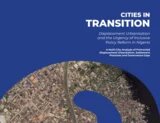Cities in Transition
Nigeria hosts an estimated 4.5 million internally displaced persons (IDPs) and 7.9 million people in need of humanitarian assistance (OCHA, 2024). Yet, national and international interventions have largely focused on the Northeast region, home to just about 40 per cent of IDPs. In comparison, nearly 60 per cent have migrated to cities across the country where they remain invisible, unrecognised, and excluded from formal systems of protection.
This massive trend toward urban migration has exposed a critical knowledge gap in Nigeria's post-conflict mobility. This gap is marked by insufficient data, as well as the absence of clear definitions for urban IDPs and a limited understanding of their distinct needs for services and protection compared to non-displaced urban populations.
This publication, "Cities in Transition", presents findings and the urgent call for inclusive policy reform in Nigeria, from a seven-year collaboration between the University of Lagos, Technische Universität Berlin, and civil society partners, with its deep dive and launch supported by Heinrich Böll Stiftung-Abuja Office. Data are drawn from participatory mapping conducted in ten Nigerian cities, with a particular focus on 67 IDP settlements in Lagos and along the Lagos-Ogun State fringes.
